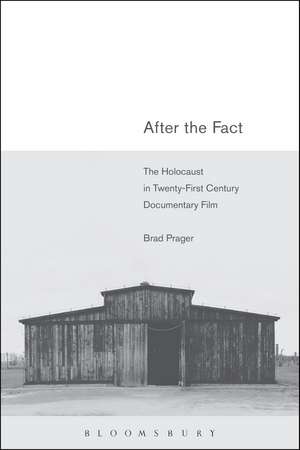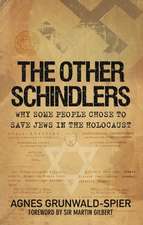After the Fact: The Holocaust in Twenty-First Century Documentary Film
Autor Dr Brad Prageren Limba Engleză Paperback – 25 mar 2015
| Toate formatele și edițiile | Preț | Express |
|---|---|---|
| Paperback (1) | 193.62 lei 6-8 săpt. | |
| Bloomsbury Publishing – 25 mar 2015 | 193.62 lei 6-8 săpt. | |
| Hardback (1) | 716.63 lei 6-8 săpt. | |
| Bloomsbury Publishing – 25 mar 2015 | 716.63 lei 6-8 săpt. |
Preț: 193.62 lei
Preț vechi: 223.97 lei
-14% Nou
Puncte Express: 290
Preț estimativ în valută:
37.06€ • 38.58$ • 31.32£
37.06€ • 38.58$ • 31.32£
Carte tipărită la comandă
Livrare economică 10-24 martie
Preluare comenzi: 021 569.72.76
Specificații
ISBN-13: 9781623564445
ISBN-10: 1623564441
Pagini: 304
Ilustrații: 36 bw illus
Dimensiuni: 152 x 229 x 23 mm
Greutate: 0.45 kg
Editura: Bloomsbury Publishing
Colecția Bloomsbury Academic
Locul publicării:New York, United States
ISBN-10: 1623564441
Pagini: 304
Ilustrații: 36 bw illus
Dimensiuni: 152 x 229 x 23 mm
Greutate: 0.45 kg
Editura: Bloomsbury Publishing
Colecția Bloomsbury Academic
Locul publicării:New York, United States
Caracteristici
Offers innovative approaches to documentary film that address fields including Visual Studies
Notă biografică
Brad Prager is Associate Professor of German and a member of the Program in Film Studies at the University of Missouri. He is the author of The Cinema of Werner Herzog: Aesthetic Ecstasy and Truth (2007) and Aesthetic Vision and German Romanticism: Writing Images (2007). He is also the coeditor of a volume on Visual Studies and the Holocaust entitled Visualizing the Holocaust: Documents, Aesthetics, Memory (2008), as well as of a recent volume on contemporary German cinema, and is the editor of a Companion to Werner Herzog (2012).
Cuprins
Acknowledgments Introduction: The Holocaust Documentary: In Stages Touring Sites: Revisiting the Concentration Camps in KZ and Martin Mediated Memories: The Influence of Spielberg's Hollywood Hit on Inheritance and Spielberg's List Forgiveness on Film: Resentment and Reconciliation in Forgiving Dr. Mengele and Landscapes of Memory: The Life of Ruth Klüger Family Issues: Oedipal Confrontations in 2 or 3 Things I Know about Him and The Flat Re-Screening Perpetrator Images: Witnessing the Past in A Film Unfinished and Photographer Conclusion Selected Filmography Works Cited Index
Recenzii
Published on the 75th anniversary of the end of the Second World War ... After the Fact is a timely and valuable contribution to discussions about the power of cinema ... Fascinating.
[Prager's] impressive discussions tease out meanings and implications, and his readings are copiously annotated with interesting additional comments and references ... So superb are his readings that he motivated me to seek out these films in whatever venues I could, from Netflix to YouTube ... Prager's sympathy and patience while reading and assessing the films he has selected so effectively is always illuminating ... Few books I have reviewed recently on Holocaust cinema ... have challenged my thinking in more thought-provoking ways.
After the Fact offers not only a compelling analysis of representations of the Holocaust in 21st century documentary film, but carefully traces the history of Holocaust documentaries from Nazi Concentration Camps (1945) to Branko: Return to Auschwitz (2013). This is an important contribution to contemporary research in Holocaust, German, and Film Studies that highlights relevant theoretical contexts and asks key questions.
Brad Prager's After the Fact is a beautifully written, deeply informed meditation on a whole raft of at once ethical and aesthetic-conceptual issues currently confronting scholars of the Holocaust. It provides superb original critical readings of ten of the most recent filmic interventions in the longstanding, wrenching argument about the very 'unrepresentability' of extreme horror - offering us new insights into such vexed issues as concentration camp tourism, intergenerational and intrafamilial conflict over transmission of trauma, and the impact of the digital age on emotional confrontations with guilt and responsibility. But the book does much, much more than that, as it also demonstrates intimate familiarity with - and provides deft renderings of - a range of post-Holocaust debates and the agonizing dilemmas posed to Holocaust documentarians in particular by the inescapable instability and contestedness of historical truth. A tremendous achievement and an extraordinary resource for classroom use, one from which historians and cinema studies scholars alike will learn a great deal.
Brad Prager's After the Fact is brilliantly iconoclastic. Focusing on post-millennial Holocaust documentaries, Prager reflects on contemporary documentaries made under the shadow of Alain Resnais's Night and Fog (1955), and Claude Lanzmann's epic Shoah (1985). Rightly, Prager pays deference to the history of cinematic treatments of the Holocaust. At the same time though, he challenges conventional views, and the veritable "commandments" handed down by figures like Lanzmann on the "proper" way to represent the Holocaust. This is a welcomed nuanced discussion of post-millennial Holocaust documentaries-fully appreciating the specificity of cinematic narration. Hardly a "transparent window" on to the past, documentaries are narratives that frame a subject, and Prager productively problematizes what documentaries can and cannot tell us. As spectators, Prager invites us to (re)consider the certainty of our moral footing-which is precisely what many of the films he discusses do. After the Fact challenges sentimental and fetishistic visions of the Holocaust-whether as images of abject suffering, or the idealization of survivors-and refuses to function as a platform for platitudes. What Prager so vividly highlights is the degree to which post-millennial Holocaust documentaries are aware of the Holocaust as rendered in cinematic history. Whether a reader comes to this book from film studies, Holocaust/genocide studies, history, or some other disciplinary tradition what they will assuredly take away from it is this: a much deeper appreciation of contemporary documentaries, and the complexities of representing a catastrophic event that is quickly receding beyond the reach of living-memory.
Prager's discussions contain penetrating insights into significant ethical issues of Holocaust representations such as fidelity to historical truths, the emotional impact and educational value of Holocaust documentaries, the handling of survivor testimony, and the questionable use of perpetrator images from propaganda films.
[Prager's] impressive discussions tease out meanings and implications, and his readings are copiously annotated with interesting additional comments and references ... So superb are his readings that he motivated me to seek out these films in whatever venues I could, from Netflix to YouTube ... Prager's sympathy and patience while reading and assessing the films he has selected so effectively is always illuminating ... Few books I have reviewed recently on Holocaust cinema ... have challenged my thinking in more thought-provoking ways.
After the Fact offers not only a compelling analysis of representations of the Holocaust in 21st century documentary film, but carefully traces the history of Holocaust documentaries from Nazi Concentration Camps (1945) to Branko: Return to Auschwitz (2013). This is an important contribution to contemporary research in Holocaust, German, and Film Studies that highlights relevant theoretical contexts and asks key questions.
Brad Prager's After the Fact is a beautifully written, deeply informed meditation on a whole raft of at once ethical and aesthetic-conceptual issues currently confronting scholars of the Holocaust. It provides superb original critical readings of ten of the most recent filmic interventions in the longstanding, wrenching argument about the very 'unrepresentability' of extreme horror - offering us new insights into such vexed issues as concentration camp tourism, intergenerational and intrafamilial conflict over transmission of trauma, and the impact of the digital age on emotional confrontations with guilt and responsibility. But the book does much, much more than that, as it also demonstrates intimate familiarity with - and provides deft renderings of - a range of post-Holocaust debates and the agonizing dilemmas posed to Holocaust documentarians in particular by the inescapable instability and contestedness of historical truth. A tremendous achievement and an extraordinary resource for classroom use, one from which historians and cinema studies scholars alike will learn a great deal.
Brad Prager's After the Fact is brilliantly iconoclastic. Focusing on post-millennial Holocaust documentaries, Prager reflects on contemporary documentaries made under the shadow of Alain Resnais's Night and Fog (1955), and Claude Lanzmann's epic Shoah (1985). Rightly, Prager pays deference to the history of cinematic treatments of the Holocaust. At the same time though, he challenges conventional views, and the veritable "commandments" handed down by figures like Lanzmann on the "proper" way to represent the Holocaust. This is a welcomed nuanced discussion of post-millennial Holocaust documentaries-fully appreciating the specificity of cinematic narration. Hardly a "transparent window" on to the past, documentaries are narratives that frame a subject, and Prager productively problematizes what documentaries can and cannot tell us. As spectators, Prager invites us to (re)consider the certainty of our moral footing-which is precisely what many of the films he discusses do. After the Fact challenges sentimental and fetishistic visions of the Holocaust-whether as images of abject suffering, or the idealization of survivors-and refuses to function as a platform for platitudes. What Prager so vividly highlights is the degree to which post-millennial Holocaust documentaries are aware of the Holocaust as rendered in cinematic history. Whether a reader comes to this book from film studies, Holocaust/genocide studies, history, or some other disciplinary tradition what they will assuredly take away from it is this: a much deeper appreciation of contemporary documentaries, and the complexities of representing a catastrophic event that is quickly receding beyond the reach of living-memory.
Prager's discussions contain penetrating insights into significant ethical issues of Holocaust representations such as fidelity to historical truths, the emotional impact and educational value of Holocaust documentaries, the handling of survivor testimony, and the questionable use of perpetrator images from propaganda films.













